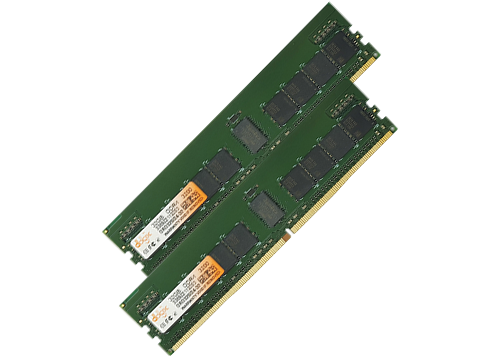2GB DDR2
DDR-2 SDRAM (Double Data Rate type Two Synchronous Dynamic Random Access Memory) is the successor to DDR SDRAM. DDR2 improves performance over DDR by doubling the bus speed, allowing four data transfers per internal clock cycle. This results in higher data transfer rates and increased bandwidth, despite having the same internal clock speed. DDR2 uses lower voltage (1.8V compared to 2.5V for DDR), which helps in reducing power consumption. However, DDR2 has higher latency than DDR due to additional buffering, but the increased speed usually compensates for it. DDR2 modules are not backward compatible with DDR or DDR3 slots due to differences in keying, signaling, and electrical characteristics.
DDR2 SDRAM modules use DDR architecture to achieve high-speed operation. DDR2 architecture is basically an 8n-prefetch architecture which transfers two data words per clock cycle at the input-output pins. Initially it was launched with 1.5v DDR2 DRAM; later DDR2 DRAM works at 1.35v. 1.35v is usually compatible with all 1.5v platforms. Long-DIMM (or Desktop RAM) comprises of 240 connector pins, whereas SO-DIMM (Laptop RAM) comprises of 204 connector pins. Long DIMM of both DDR2 and DDR2 has 240 pins, but they can easily be identified as their notch location of DDR2 is nearer to pin 1 as opposed to DDR2 Long-DIMM. It typically has data transfer rates of PC3-6400 (800MT/s), PC3-8500 (1066MT/s), PC3-10600 (1333MT/s), PC3-12800 (1600MT/s), or PC3-14900 (1866MT/s).

| SDRAM | Capacity | DIMM | MHz | Buffer | ECC | PIN | PC-Speed | CL | ns | Module Density | DQ |
|---|---|---|---|---|---|---|---|---|---|---|---|
| DDR2 | 2GB | Long | 800 | Un-Buffered | Non-ECC | 240 | PC2-6400 | 6 | 2.5 | 256Mx64bit | x64 |
| DDR2 | 2GB | SO | 800 | Un-Buffered | Non-ECC | 200 | PC2-6400 | 6 | 2.5 | 256Mx64bit | x64 |
| DDR2 | 2GB | Long | 667 | Un-Buffered | Non-ECC | 240 | PC2-5300 | 5 | 3 | 256Mx64bit | x64 |
| DDR2 | 2GB | SO | 667 | Un-Buffered | Non-ECC | 200 | PC2-5300 | 5 | 3 | 256Mx64bit | x64 |
